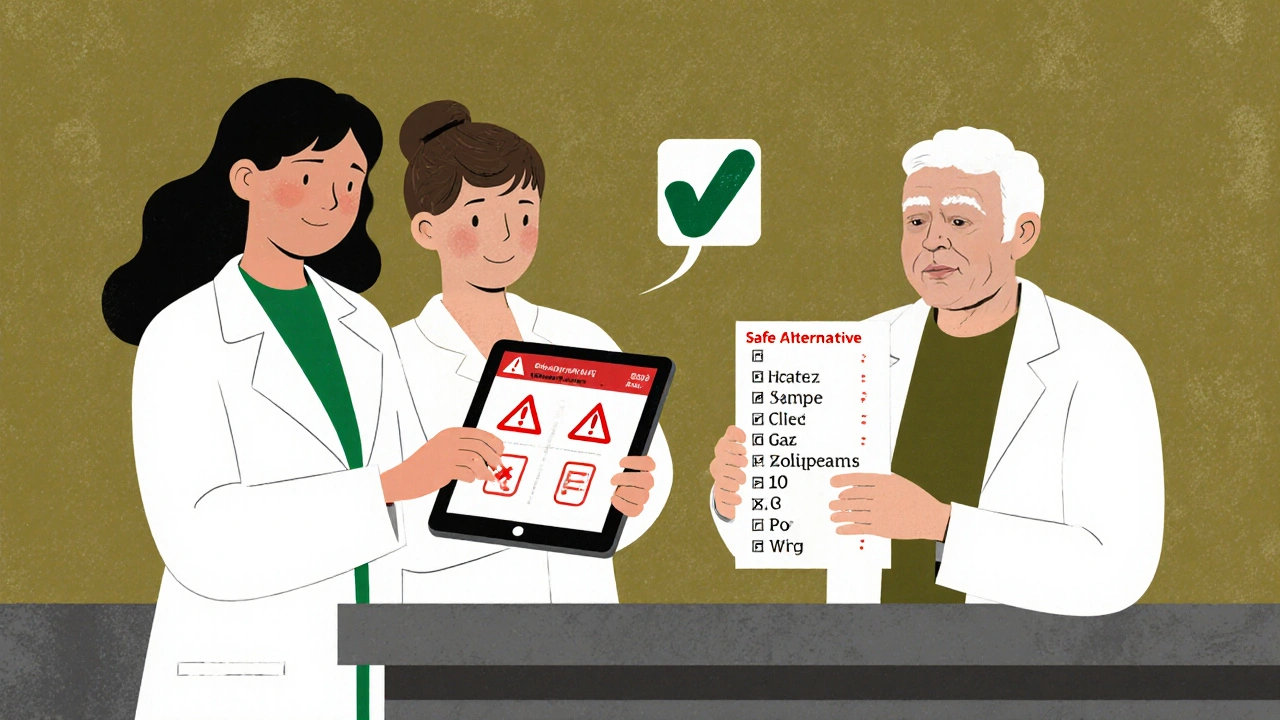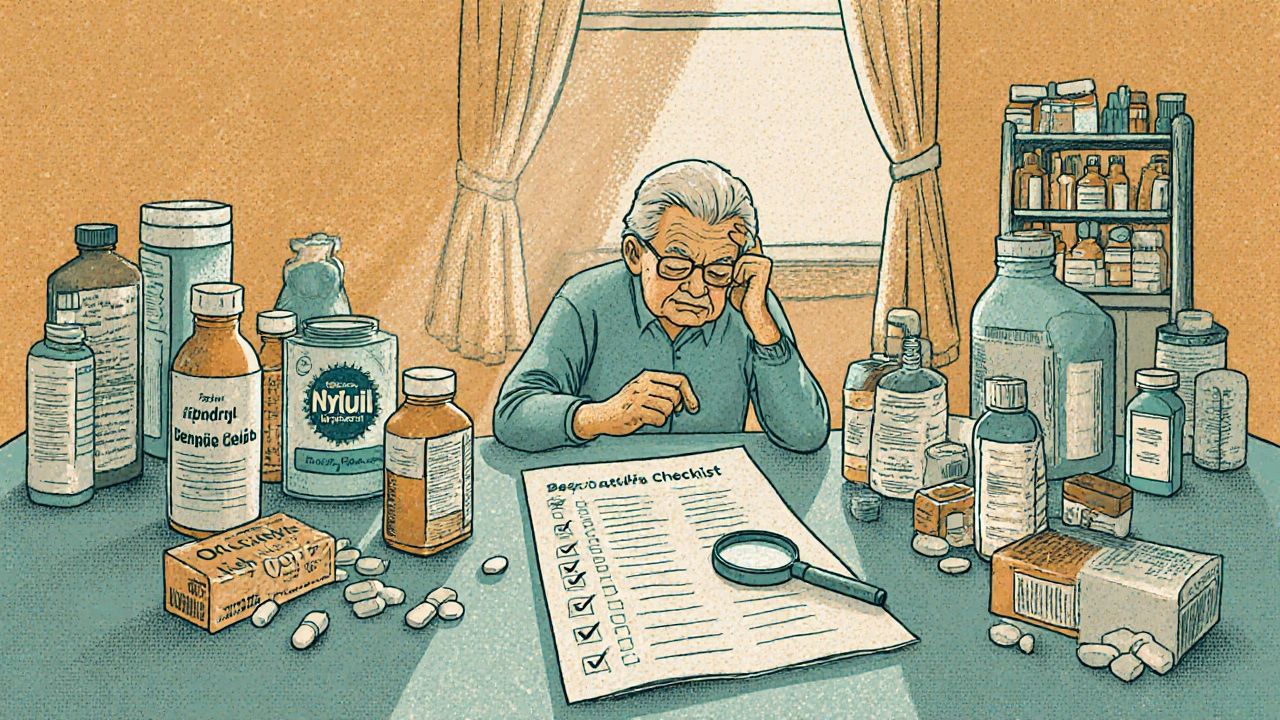Every year, thousands of older adults end up in the hospital not because of a new illness, but because of a medication they were prescribed. It’s not always the drug’s fault-it’s often the Beers Criteria being ignored. These guidelines, updated in 2023, are designed to stop doctors from prescribing drugs that do more harm than good to people over 65. They’re not about banning medicines. They’re about making smarter choices when the body changes with age.
What Are the Beers Criteria?
The Beers Criteria are a list of medications that experts agree should be avoided-or used with extreme caution-in older adults. Developed in 1991 by Dr. Mark Beers and updated every few years by the American Geriatrics Society, the latest version includes 131 specific drug warnings. These aren’t random opinions. They’re based on over 1,500 scientific studies reviewed between 2019 and 2022.
It’s not just about one bad pill. It’s about how aging affects the body. As we get older, our kidneys slow down. Our liver processes drugs differently. Our brains become more sensitive to sedatives. What was safe at 50 might be dangerous at 75. The Beers Criteria map these changes and flag drugs that increase the risk of falls, confusion, kidney damage, or even death.
Five Categories of Risky Medications
The 2023 Beers Criteria break down risky drugs into five clear groups:
- Drugs to avoid in almost all older adults-like anticholinergics (e.g., diphenhydramine in Benadryl), certain sleep aids (e.g., zolpidem), and NSAIDs like ibuprofen for long-term use. These can cause dizziness, memory loss, or stomach bleeding.
- Drugs to avoid if you have certain conditions-for example, antipsychotics like haloperidol should never be used for behavioral issues in dementia patients. They double the risk of stroke and sudden death.
- Drugs to use with caution-medications like benzodiazepines (e.g., lorazepam) or muscle relaxants (e.g., cyclobenzaprine) can be okay short-term but become dangerous with regular use.
- Drugs to avoid if kidneys are impaired-many drugs, including metformin and certain antibiotics, build up in the body if kidneys aren’t working well. This can lead to toxicity.
- Drug combinations to avoid-like taking an SSRI antidepressant with an NSAID. Together, they raise the risk of dangerous bleeding.
Each warning includes a level of evidence. Some are labeled "strongly discouraged" because multiple studies show clear harm. Others are "caution advised" because the risk depends on the person’s health, kidney function, or other medications.
Why Do These Drugs Still Get Prescribed?
It’s not that doctors don’t know better. Often, they’re under pressure. A patient complains of insomnia, and a quick script for zolpidem feels faster than talking about sleep hygiene. A family member asks for something to calm a loved one with dementia, and an antipsychotic seems like the only option. In nursing homes, where staff are stretched thin, sedatives are sometimes used to manage behavior-not because they help, but because they make care easier.
And here’s the catch: many of these drugs are still sold over the counter. Diphenhydramine is in sleep aids, cold medicines, and allergy pills. Older adults might take several products without realizing they’re all loading their system with the same dangerous chemical. One 2014 study found that nearly half of older adults in long-term care were on at least one Beers Criteria-listed drug.
What’s the Real Risk?
The consequences aren’t theoretical. Studies show that older adults on Beers Criteria-listed drugs are:
- 60% more likely to be hospitalized for adverse drug events
- 3 times more likely to suffer a fall leading to fracture
- Up to 50% more likely to develop confusion or memory loss
- At higher risk of kidney failure or gastrointestinal bleeding
One 2012 study found that nearly 20% of older adults in the U.S. were prescribed at least one medication flagged by the Beers Criteria. And for people with multiple chronic conditions-common in this age group-the risk multiplies. When someone takes eight or ten pills a day, the chance of a harmful interaction goes up dramatically.

It’s Not About Banning Medicines
The American Geriatrics Society is clear: the Beers Criteria are not rules. They’re a warning system. There are exceptions. Sometimes, a drug on the list is the only thing that works. For example, a patient with severe Parkinson’s might need an anticholinergic because nothing else controls their tremors. Or someone with chronic pain might need a low-dose NSAID if they can’t tolerate opioids.
The key is intentional use. That means:
- Knowing why the drug is being prescribed
- Checking for alternatives
- Starting low and going slow
- Monitoring closely for side effects
- Reassessing regularly
It’s not about saying no to every risky drug. It’s about saying yes only when the benefit clearly outweighs the risk-and only after considering all other options.
Tools That Help
Doctors and pharmacists don’t have to memorize 131 drugs. The American Geriatrics Society offers free tools:
- A mobile app with searchable criteria
- A pocket-sized card for quick reference
- An online version at GeriatricsCareOnline.org
Many electronic health records now include alerts that pop up when a doctor tries to prescribe a Beers Criteria drug to an older patient. These alerts aren’t perfect-they can be annoying if overused-but they help start the conversation.
Patients and families can also use the free resources at healthinaging.org to understand what’s in their medicine cabinet and ask better questions.
What About Other Tools Like STOPP-START?
The Beers Criteria focus on what not to prescribe. STOPP-START does something different: it also looks at what’s being missed. For example, an older adult with heart failure might not be on a beta-blocker they need. STOPP-START catches those gaps. Many hospitals now use both tools together. But Beers remains the most widely adopted in the U.S., especially in Medicare programs and nursing home quality reports.
The Centers for Medicare & Medicaid Services (CMS) uses Beers Criteria data to rate nursing homes. That’s led to better prescribing-but also to some unintended pressure. Some facilities avoid prescribing certain drugs altogether, even when they might be appropriate, just to look good on paper. That’s why experts stress: guidelines are tools, not punishments.

What Can You Do?
If you or a loved one is over 65 and taking multiple medications:
- Ask for a full medication review with a pharmacist or geriatrician
- Bring a complete list of all pills, supplements, and OTC drugs
- Ask: "Is this still necessary? Are there safer alternatives?"
- Ask: "What happens if we stop this?"
- Don’t assume a drug is safe just because it’s been taken for years
Deprescribing-gradually stopping unnecessary meds-is now a recognized part of good care. It’s not about taking fewer pills for the sake of it. It’s about taking only the ones that truly help.
The Bigger Picture
Polypharmacy-the use of five or more medications-is common in older adults. About 40% of people over 65 take five or more prescriptions. And 20% of those are potentially inappropriate. That’s not normal. It’s a system problem.
Doctors aren’t bad. Pharmacies aren’t careless. But the system rewards quick fixes. It doesn’t reward time spent reviewing meds, talking to patients, or coordinating care. The Beers Criteria are a wake-up call. They’re not perfect, but they’re the best tool we have to push for better, safer care.
Medication safety in older adults isn’t about avoiding all drugs. It’s about choosing the right ones, for the right reasons, at the right dose-and being willing to let go of the ones that no longer serve the person.
Are all drugs on the Beers Criteria list completely unsafe for older adults?
No. The Beers Criteria list drugs that carry higher risks, but they’re not absolute bans. Some older adults may still benefit from these medications if other options don’t work, their condition is severe, or they’re closely monitored. The key is intentional prescribing-weighing risks and benefits for each individual, not applying the list mechanically.
Can over-the-counter medicines be dangerous for older adults?
Yes. Many OTC drugs like diphenhydramine (in Benadryl, NyQuil, or sleep aids) are on the Beers Criteria list because they can cause confusion, dizziness, urinary retention, and falls. Older adults often take these without realizing they’re interacting with prescription drugs or worsening existing conditions like glaucoma or prostate issues.
How often are the Beers Criteria updated?
The American Geriatrics Society updates the Beers Criteria every 3 to 5 years. The most recent version was published in 2023, based on over 1,500 new studies. Updates include new drug warnings, stronger cautions on antipsychotics and benzodiazepines, and expanded guidance for kidney impairment.
Is the Beers Criteria used in the UK and other countries?
The Beers Criteria were developed in the U.S. and are most commonly used there. Other countries use similar tools, like the STOPP-START criteria, which are more widely adopted in Europe and the UK. However, many international clinicians reference the Beers Criteria as a global standard for identifying inappropriate prescribing in older adults.
Can electronic health records help reduce inappropriate prescribing?
Yes. Many EHR systems now include clinical decision support alerts that flag Beers Criteria drugs when prescribed to older patients. These alerts don’t prevent prescribing-they prompt the clinician to reconsider. Studies show they reduce inappropriate prescribing by up to 30% when properly implemented and not overridden too often.
What should I do if my doctor prescribes a drug on the Beers list?
Ask why this drug was chosen over alternatives. Request a review of all your medications. Ask if it’s possible to try a safer option first, or if the drug is truly necessary. Bring a list of all your current meds, including supplements and OTCs. Don’t be afraid to seek a second opinion from a geriatrician or pharmacist specializing in older adults.
Next Steps for Safer Medication Use
If you’re managing medications for an older adult, start with these three actions:
- Get a full medication reconciliation-every pill, patch, and OTC product-written down.
- Schedule a medication review with a pharmacist who works with older patients.
- Ask: "What’s the goal of this drug? What happens if we stop it?"
Medication safety isn’t about fear. It’s about awareness. The Beers Criteria aren’t a threat-they’re a guide. Used wisely, they help older adults live longer, healthier, and more independent lives-not by avoiding all drugs, but by using only the ones that truly matter.


Cris Ceceris
Man, I’ve seen this play out with my grandma. She was on Benadryl for sleep for years-never thought twice about it. Then she started stumbling around the house, forgetting where the bathroom was. Turned out, it was the diphenhydramine. Took her a month to recover after they weaned her off. These criteria aren’t just guidelines-they’re lifelines.